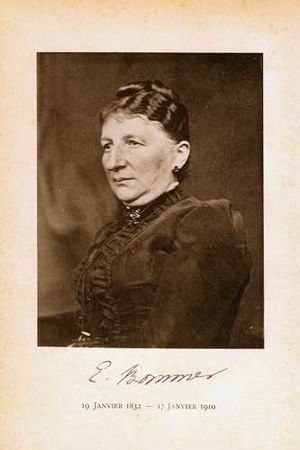Elise Caroline Bommer facts for kids
Elisa Caroline Bommer (born January 20, 1832, died January 17, 1910) was a famous Belgian botanist. She was an expert in mycology, which is the scientific study of fungi, like mushrooms and molds. She discovered and described more than 200 types of fungi in her lifetime.
Elisa worked closely with her husband, Jean-Édouard Bommer, who was also a botanist. He was an expert on ferns and a professor at the University of Brussels. Together, they formed a family dedicated to studying the world of plants.
Contents
A Scientist's Journey Begins
From a Royal Castle to Botany
Elisa's love for nature started at a young age. Her father worked at the Royal Castle of Laeken, the home of the Belgian King. This allowed Elisa to explore the huge and beautiful park surrounding the castle.
At age ten, she went to a boarding school. At first, she missed the freedom of the castle grounds, but she soon got used to her new life. She also became a talented musician. When she was twenty, she started a business career, but the long hours made her unhappy and unwell.
A family doctor knew about her passion for plants. He introduced her to Jean-Édouard Bommer, a botanist who studied ferns. They shared a love for science and got married in 1863. Their son, Charles Bommer, later became a palaeobotanist, a scientist who studies fossil plants.
Exploring the World of Fungi
Even while raising a family, Elisa became a dedicated botanist. She found a great scientific partner in her friend, Mariette Rousseau. Together, they decided to study the fungi of Belgium. At the time, not many scientists had explored this topic.
They used the work of earlier botanists like Jean Kickx to guide them. They also spent a lot of time studying in the library of the local botanical garden. Their hard work paid off, and they began to publish their discoveries.
Discoveries from Around the World
Elisa Bommer and Mariette Rousseau wrote many important scientific papers. They described the fungi they found near Brussels and in other parts of Belgium.
Their work wasn't just local. They also studied fungi from faraway places. In 1896, they published a paper on fungi from Costa Rica. These samples were collected by the explorer Henri François Pittier.
Most amazingly, they studied fungi from Antarctica! These were collected during a Belgian expedition from 1897 to 1899, led by Adrien de Gerlache. Their report on these Antarctic fungi was published in 1905. This showed how important their work was to scientists around the globe.
Later Life and Lasting Impact
Later in life, Elisa had health problems that made it hard for her to get around. However, she never lost her passions. She continued to play the piano and began painting beautiful pictures of fungi and flowers.
When she died, her huge collection of fungi was given to the National Botanic Garden of Belgium. Today, it is kept safely in the herbarium in Meise. This collection is still used by scientists.
To honor her amazing contributions to science, a type of fungus was named after her: the genus Bommerella.
Important Scientific Writings
Elisa Bommer and Mariette Rousseau published many important scientific articles, called papers, about their discoveries. These papers helped other scientists understand the world of fungi. Some of their key publications were:
- Catalogue of mushrooms observed in the vicinity of Brussels (1879)
- Mycological flora of the Brussels area (1884)
- Fungi of Costa Rica (1896)
- Mushrooms of the S. Y. Belgica Expedition to Antarctica (1905)
Images for kids
See also
 In Spanish: Elisa Caroline Bommer para niños
In Spanish: Elisa Caroline Bommer para niños




